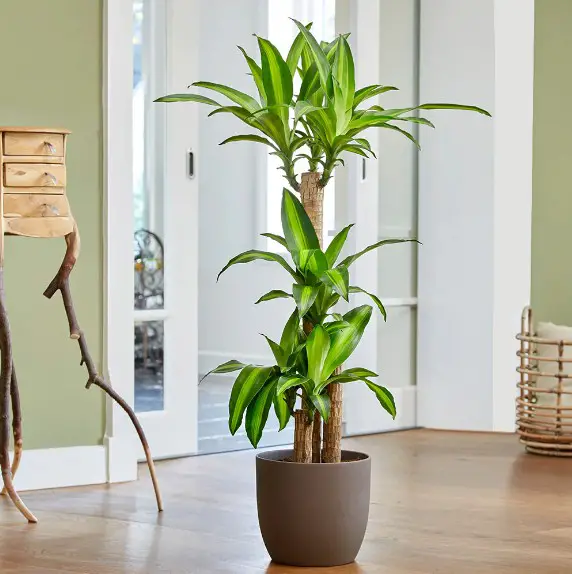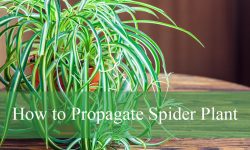The Dracaena corn plant, scientifically known as Dracaena fragrans, is a popular choice among houseplant enthusiasts due to its striking appearance and resilience. With its tall, arching leaves and the ability to adapt to various indoor conditions, this evergreen shrub not only enhances the aesthetic appeal of any space but also purifies the air, making it a valuable addition to homes and offices alike.
However, to ensure the health and longevity of your corn plant, it’s essential to understand its specific care requirements, including optimal lighting, watering, soil conditions, and pest management. In this comprehensive guide, we’ll explore everything you need to know about growing and caring for Dracaena corn plants, from propagation techniques to troubleshooting common issues.
Whether you’re a seasoned gardener or a novice plant parent, this guide will equip you with the knowledge to cultivate a thriving corn plant that brings beauty and vitality to your environment.
About Dracaena Corn Plant

Dracaena Corn Plant (Dracaena fragrans), commonly known as the corn plant or false palm, is a striking member of the Asparagaceae family, characterized by its broad, evergreen foliage that adds a tropical touch to both indoor and outdoor spaces. Reaching mature heights of 15 to 50 feet outdoors and up to 6 feet indoors, this adaptable shrub or tree thrives in partial sunlight, making it a popular choice for homes and gardens.
The corn plant prefers moist, well-draining loamy soil, with a slightly acidic pH ranging from 6.1 to 6.5. Its blooming period occurs in late fall and again in late spring, showcasing fragrant flowers that can be white or yellow, primarily blooming at night. The Dracaena corn plant is hardy in USDA zones 10 to 12, indicating its preference for warmer climates, native to the tropical regions of Africa.
While it makes an attractive addition to many households, it is essential to note that this plant is toxic to dogs and cats, so pet owners should exercise caution. With its impressive stature and lush foliage, the Dracaena corn plant is not only a beautiful decorative piece but also a fascinating addition to any plant lover’s collection.
Dracaena Corn Plant Care
Dracaena Corn Plant care is essential for maintaining its lush appearance and overall health. Typically grown as large potted plants indoors, corn plants thrive in climate-controlled conditions due to their tropical origins. During the summer months, you can place them outdoors in a sheltered, partially shady location; however, it’s important to bring them back inside when temperatures begin to drop into the 60s.
For optimal growth, plant corn plants in a rich, well-draining potting mix to ensure they receive adequate moisture without becoming waterlogged. They prefer bright, indirect light, so it’s crucial to avoid placing them in direct sunlight, which can scorch their leaves. Additionally, protect your corn plant from drafts and extreme temperatures by positioning it away from cold or drafty windows, air conditioners, and heating vents. A humid environment is ideal for these plants, so consider misting them or using a humidity tray to create the right conditions for healthy growth. With proper care, your Dracaena corn plant will flourish and add a vibrant touch to your indoor space.
Light
Light is a crucial factor in the care of the Dracaena corn plant, influencing its overall health and aesthetic appeal. The ideal indoor location for this tropical plant is near a window that provides filtered sunlight, allowing it to receive the bright light it craves without the harshness of direct rays. Insufficient light can lead to a loss of color variegation in the leaves, resulting in a duller appearance and potentially stunting the plant’s growth. Conversely, exposure to direct sunlight can be detrimental, causing the leaves to scorch, wilt, and develop unsightly brown edges.
When placed outdoors, the corn plant thrives best in a shadier spot where it is protected from the intense afternoon sun. This balance of light exposure—bright yet indirect—is vital for maintaining the vibrancy and lushness of the leaves while promoting healthy growth.
Soil
Soil quality is vital for the successful growth of Dracaena corn plants, with a loose, loamy potting soil mix being the optimal choice. This type of soil provides the right balance of drainage, aeration, and nutrient retention that corn plants need to thrive. When selecting or creating a potting mix, it’s essential to ensure that it includes components like peat moss, perlite, or vermiculite, which contribute to the soil’s light texture and help maintain moisture without becoming waterlogged.
Good drainage is crucial for corn plants, as their roots are sensitive to standing water and can quickly suffer from root rot if kept too wet. To enhance drainage, consider using pots with drainage holes and adding a layer of coarse gravel or stones at the bottom. This setup allows excess water to escape, ensuring that the roots remain healthy and well-oxygenated.
Watering
Watering is a critical aspect of caring for Dracaena corn plants, requiring a careful balance to promote healthy growth. During the growing season, which spans from spring through fall, it’s essential to keep the soil evenly moist but not soggy. This means checking the top inch of the soil regularly; if it feels dry to the touch, it’s time to water. Ensuring that water penetrates thoroughly but drains well will help maintain the right moisture level without overwhelming the plant.
As temperatures begin to drop in late fall and throughout winter, it’s important to reduce the frequency of watering. However, you should never allow the soil to completely dry out, as this can lead to stress and health issues for the plant. Signs of improper watering include yellowing leaves or leaf drops, which may indicate that the soil is either too wet or too dry.
Temperature and Humidity
Temperature and Humidity are vital components in ensuring the health and vitality of Dracaena corn plants. These tropical plants thrive in temperatures ranging from 60°F to 75°F, making them well-suited for indoor environments. It is essential to avoid exposing them to temperatures in the 50s, as such cold conditions can lead to stress and hinder their growth. If you decide to move your corn plants outdoors for the summer to enjoy the natural light and warmth, be vigilant about bringing them back indoors before temperatures drop into the lower range.
Humidity levels also play a significant role in the overall well-being of corn plants, as they naturally prefer humidity between 40 to 50 percent, closely mimicking their native tropical environment. To maintain these humidity levels, you can use a humidifier in the room where the plant is located. Alternatively, placing the pot on a tray filled with water and pebbles can effectively raise the humidity around the plant. However, it’s crucial to ensure that the bottom of the pot does not touch the water, as this can lead to root rot.
Fertilizer
Fertilizer is an important aspect of maintaining the health and vigor of Dracaena corn plants, which thrive in organically rich soil. To promote optimal growth, it is beneficial to apply a balanced liquid fertilizer every other month during the growing season, typically from spring through fall. This regular feeding provides essential nutrients that support robust foliage and overall plant vitality. When selecting a fertilizer, look for one that is formulated for indoor plants or tropical foliage, ensuring it contains equal parts of nitrogen, phosphorus, and potassium to encourage balanced growth.
As the growing season comes to a close and winter approaches, it’s advisable to reduce or even eliminate fertilization. During the winter months, the corn plant’s growth slows significantly, and it requires fewer nutrients. Over-fertilizing in this period can lead to salt buildup in the soil, which may harm the roots and affect the plant’s health.
Overwintering
Overwintering is a crucial step for the care of Dracaena corn plants, especially for those grown outdoors in regions with cooler climates. When temperatures begin to dip below 60°F, it is essential to bring your dracaena indoors to protect it from cold stress and potential damage. If the plant is in the ground and you have a sufficiently large planter, you can carefully dig out the root ball and transfer it to a pot, ensuring minimal disruption to its roots.
For those living in areas cooler than USDA Zone 10, leaving the corn plant in the ground during winter is not an option, as it will not survive the colder temperatures. However, before the first frost, you can take proactive measures by taking a stem cutting or cutting off the top of the plant. These cuttings can be propagated indoors during the winter months, allowing you to preserve the plant and promote new growth. Once the threat of frost has passed in spring, you can replant the propagated cuttings outdoors, giving your Dracaena corn plant a fresh start for the growing season.
Common Pests
Common Pests can pose a significant threat to the health of Dracaena corn plants, making vigilant monitoring essential for maintaining their vitality. Among the most frequent culprits are spider mites, thrips, and scale insects. Spider mites can cause fine webbing on the leaves and lead to stippling, which makes the foliage appear damaged and unhealthy. Thrips, on the other hand, are tiny insects that can distort new growth and create silver streaks on the leaves. Scale insects often manifest as small, immobile bumps on the stems and leaves, sucking the sap from the plant and further contributing to its decline.
To keep your corn plant looking its best and to reduce the likelihood of pest infestations, it’s important to dust the leaves regularly with a damp cloth. This simple practice not only helps maintain the plant’s aesthetic appeal but also disrupts potential pest colonies, making it more difficult for them to establish themselves. Additionally, inspecting the undersides of the leaves and the stems can help you catch any infestations early, allowing for timely intervention.
When should you repot a Dracaena Corn Plant?
It is generally recommended to repot your Dracaena corn plant every year or two to promote healthy growth and prevent it from becoming root-bound. During the repotting process, choose a slightly larger container—typically 2 to 3 inches wider and deeper than the current one—and fill it with fresh potting soil to provide the plant with renewed nutrients and space to expand.
When you’re ready to repot, begin by gently removing the loose soil around the plant’s root ball. Carefully lift the plant from its base to avoid damaging the roots. Once the plant is out of its old container, place an inch or two of fresh potting soil at the bottom of the new container. Center the plant in its new pot, ensuring that it sits upright and stable. After positioning the plant, fill the surrounding space with fresh potting soil, being cautious not to pack it too tightly, as this can hinder proper drainage. Maintaining good drainage is essential to prevent root rot and ensure that the plant remains healthy.
How to Grow Dracaena Corn Plant From Seed?
How to Grow Corn Plant From Seed involves a careful process that starts with enhancing seed germination. Begin by soaking the seeds in room-temperature water for three to five days, which helps to soften the seed coat and promote sprouting. After soaking, sprinkle two to three seeds into a small pot filled with moistened seed starting mix, ensuring they are spaced apart. Lightly cover the seeds with a thin layer of the seed starting mix, as they need some light to germinate.
Next, place the pot on a warm germinating mat and cover it with clear plastic wrap to create a humid environment conducive to germination. It’s important to maintain the soil temperature between 68°F to 80°F, positioning the pot under a grow light or in a location that receives bright, indirect sunlight. Keep the soil slightly moist throughout this period, but be cautious not to overwater, as overly damp soil can lead to seed rot.
Once you start to see growth, which can take anywhere from four to six weeks, carefully remove the plastic wrap to allow the seedlings to acclimate to normal humidity levels. When the seedlings develop two true leaves, it’s time to transplant them into a 3-inch pot filled with quality potting soil. This transition will provide them with more space to grow and thrive, setting the stage for a healthy Dracaena corn plant as it matures.
Propagating Dracaena Corn Plant
Propagating Dracaena Corn Plants is an excellent way to expand your collection and rejuvenate existing plants, with spring or summer being the ideal times for propagation. However, if you keep your corn plants indoors in a climate-controlled environment, you can successfully propagate them at any time of year. A particularly good opportunity to propagate is when your plant starts to outgrow its space, as you can create a new plant by simply cutting the top off the original parent.
The top cutting method is particularly effective for rejuvenating leaf growth and is considered the best technique for propagating Dracaena corn plants. To begin, use clean hand pruners to snip the top of the plant just below the leaf line, making sure to include at least one node (the round white bump on the stem). For a stem cutting, an 8-inch piece is ideal.
Next, place the cutting in a jar filled with room-temperature water, ensuring that half of the cutting is submerged while the other half remains above water. Position the jar in a warm, partially sunny spot to encourage root growth. Keep an eye out for roots developing at the leaf nodes submerged in water, along with some new leaf growth at the top end of the cutting.
As the water evaporates, top it off every few days, and change the water entirely every other week to prevent algae or bacterial growth. Once the stem cutting produces roots that are over 1 inch long, pot the rooted end in moist peat moss and place it in a warm, partially sunny area. Alternatively, you can plant a freshly cut stem directly in moist peat moss and wait for new leaf growth, although this method may not provide visible signs of root development like the water propagation does. Overall, rooting the stem in water tends to yield more successful results, making it the preferred method for propagating corn plants.
Typical Issues With Dracaena Corn Plants
Typical Issues With Dracaena Corn Plants can arise if the growing conditions are not properly maintained, despite being generally easy houseplants to care for. Recognizing these issues early can help you restore your plant to health and prevent further complications.
One common problem is leaves turning yellow or brown. This discoloration often indicates underlying issues beyond normal leaf aging. Yellow leaves may suggest overwatering, while brown tips typically result from excessive sun exposure. A nutrient deficiency can also cause yellowing, so it’s crucial to reassess the plant’s light exposure, soil moisture, and fertilization schedule to determine the appropriate adjustments.
Curling leaves can occur due to inconsistent watering practices—either overwatering or underwatering. Additionally, using tap water that contains high levels of minerals can contribute to this issue; letting water sit for about an hour can help reduce chlorine levels. Environmental factors such as excessive heat or low humidity can also cause curling, so ensure the plant is not positioned near heat vents or receiving too much bright light.
If you notice leaves drooping unexpectedly, this may be a response to sudden exposure to extreme temperatures or stress from root rot. While drooping can indicate underwatering, it typically develops gradually rather than suddenly.
Dry leaf tips are another sign of distress, often resulting from insufficient water or dry air. To remedy this, consider adding a humidifier to increase humidity levels and adjust your watering routine to prevent the soil from becoming too dry. Additionally, yellowing tips can be linked to over-fertilization or high fluoride levels in tap water, making distilled water a preferable choice.
A sudden loss of leaves is often a direct result of overwatering and poor drainage, which can lead to root rot. Ensuring that the pot has adequate drainage holes and that the soil is well-draining is vital to preventing this issue.
If you notice dry patches on the leaves, it may be due to too much direct sunlight. Moving the corn plant to a location with indirect light can help alleviate this problem.
Finally, a foul aroma coming from the plant, particularly if the lower half is blackening, is indicative of soft rot, a serious bacterial infection. Unfortunately, there is no remedy for this condition, and affected plants should be discarded immediately to prevent the spread of the infection.






